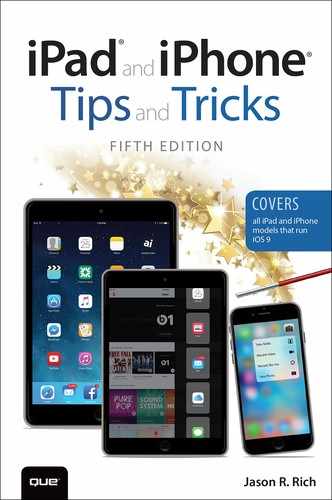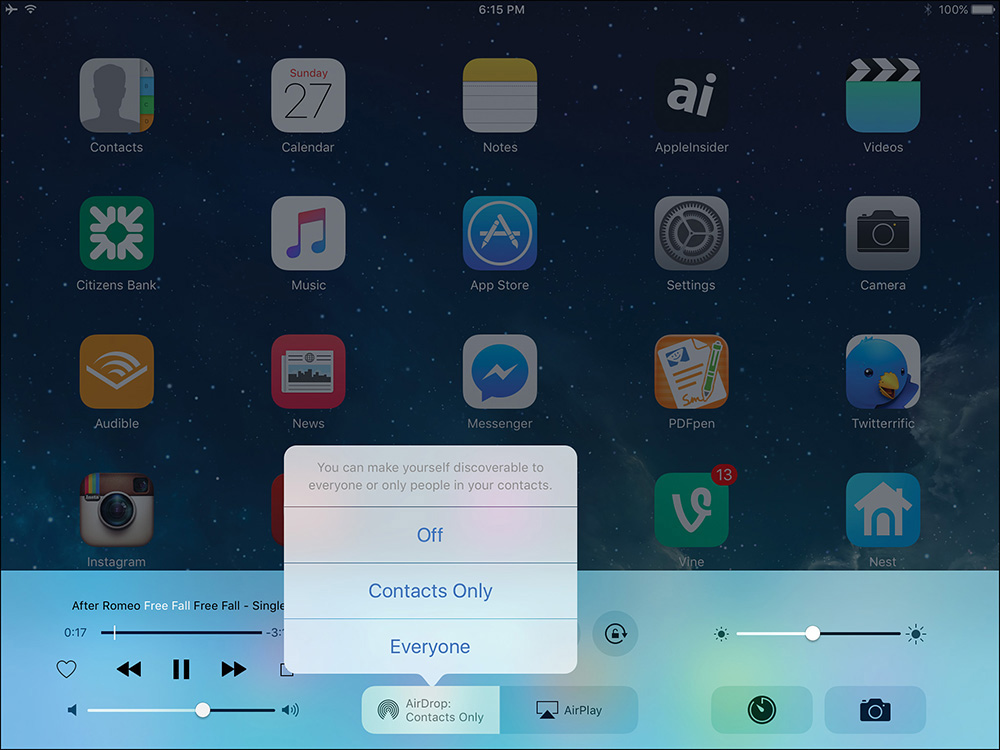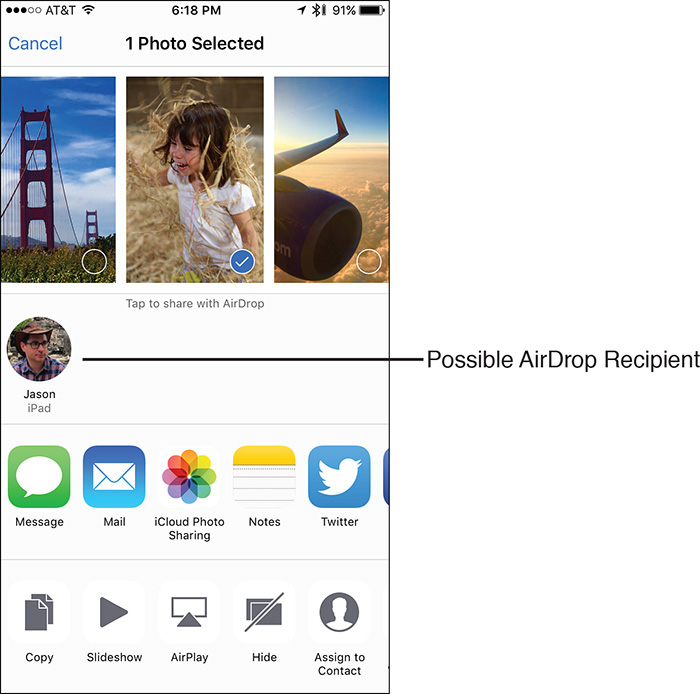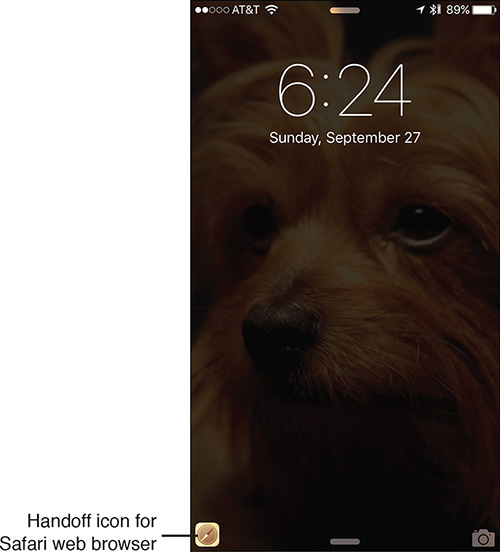4. Sync, Share, and Print Files Using AirDrop, AirPlay, AirPrint, and Handoff
In this chapter
![]() Use AirDrop to share content with other nearby Mac, iPhone, and iPad users
Use AirDrop to share content with other nearby Mac, iPhone, and iPad users
![]() Utilize your iPhone or iPad with AirPlay-compatible equipment
Utilize your iPhone or iPad with AirPlay-compatible equipment
![]() Print files wirelessly to a compatible AirPrint printer
Print files wirelessly to a compatible AirPrint printer
![]() Discover iOS 9’s Continuity and Handoff functionality
Discover iOS 9’s Continuity and Handoff functionality
When it comes to syncing and sharing files and data (including app-specific data), your iOS mobile device is equipped with several tools, including AirDrop, AirPlay, AirPrint, Continuity, and Handoff.
The AirDrop tool enables your iPhone or iPad to wirelessly transfer certain types of files (including photos) and app-specific data to other iPhones, iPads, and Macs that are in close proximity, and that also support the AirDrop function.
To turn on the AirDrop feature on your iPhone or iPad, launch Control Center by swiping your finger upward from the very bottom of the screen. When the Control Center appears, tap on the AirDrop option.
From the AirDrop menu (shown in Figure 4.1), choose whether you want to utilize AirDrop to communicate with any other nearby users (Everyone) or only with people within your Contacts database (Contacts Only). It’s also possible to turn off the feature altogether.
When it’s turned on, use this feature to send content from the Share menu that’s built in to compatible apps. For example, if you want to send a photo to another AirDrop user (or one of your other compatible Macs or mobile devices), launch Photos, view and select the photo(s) you want to send, and then tap on the Share icon.
When the Share menu is displayed (shown in Figure 4.2), thumbnails representing people in close proximity who have AirDrop turned on are displayed. Tap on the intended recipient, and the selected photos are wirelessly sent.
Figure 4.2 Select AirDrop from the Share menu of compatible apps to send app-specific content to other iOS mobile devices and Mac users.
![]() Note
Note
AirDrop is available only when using iPhones and iPads released within the last few years that are running iOS 8 or iOS 9.
If you want to use AirDrop between an iOS mobile device and a Mac, the Mac must have been released in 2012 or later and be running OS X Yosemite or OS X El Capitan.
In addition to the Photos app, the AirDrop feature is supported by the Share menu found in other apps, including Contacts, Maps, Notes, Safari, iBooks, and iTunes Store.
After you receive content via AirDrop, to access that content, launch the relevant app. For example, to view, organize, or edit photos you receive, open the All Photos/Camera Roll album in the Photos app. If you receive a Contacts entry, it is automatically added to your Contacts database and is accessible from the Contacts app.
![]() Caution
Caution
To avoid receiving unwanted content from strangers when you’re in public places such as an airport or theater, consider turning off the AirDrop feature from within Control Center and turning it on only when it’s needed. Alternatively, you can turn on AirDrop but set it up so only content from people with entries in your Contacts app’s database will be received.
Stream Content from Your iPhone or iPad to Other Compatible Devices Using Airplay
AirPlay is a wireless feature that enables your mobile device to stream content such as photos, videos, or audio, to an AirPlay-compatible device, such as Apple TV, a Mac, or AirPlay-compatible speakers.
To use AirPlay, your iOS mobile device and the other AirPlay-compatible device must be connected to the same wireless home network (via Wi-Fi). Then, when you turn on the AirPlay feature, the two compatible devices automatically establish a wireless connection.
After the connection is made, an AirPlay icon appears within compatible apps, such as Music, Videos, and Photos, enabling you to transfer (stream) what you would otherwise see on your iPhone or iPad’s screen, or what would be heard through the device’s speaker, to another compatible device.
In addition to being able to stream photos and video (including iTunes Store TV show and movie purchases and rentals), you can use AirPlay to connect external speakers (without cables) to your iOS mobile device and then stream music (from Apple Music, Pandora, Spotify, or iTunes Radio, for example) or other audio (such as audiobooks or podcasts) from your device to those compatible speakers.
When it’s available, one of the easiest ways to turn AirPlay on or off is to access it from Control Center. Tap on the AirPlay icon, and then choose where you want to stream the content to. In Figure 4.3, you see that an iPad is wirelessly connecting to Apple TV to stream a TV show saved in the iPad and display it on an HD television set via Apple TV.
![]() Tip
Tip
It’s possible to use AirPlay to present PowerPoint or Keynote digital slide presentations on a TV or monitor that has an Apple TV connected to it. What appears on the TV is exactly what’s displayed on your smartphone or tablet.
![]() More Info
More Info
AirPlay-compatible speakers are available from a handful of different companies, starting around $49.95. To learn more about AirPlay and compatible equipment, visit https://support.apple.com/en-us/HT204289.
Print Files Wirelessly Using an AirPrint-Compatible Printer
Another wireless feature offered by iOS 9 is AirPrint. It enables compatible apps to wirelessly send documents, data, or photos to be printed on an AirPrint-compatible laser, ink jet, or photo printer. For this feature to work, the iOS mobile device and the printer must be connected to the same wireless network.
![]() More Info
More Info
Dozens of different AirPrint-compatible printers are now available, from companies such as Brother, HP, Canon, Lexmark, and Epson. To learn more about AirPrint-compatible printers, visit https://support.apple.com/en-us/HT201311.
After you’ve set up an AirPrint-compatible printer, use the Print feature that’s built in to many apps, such as Pages, Notes, Safari, Maps, and Photos. The Print option is often found in the Share menu of these apps, although this can vary.
If you’re not using an AirPrint-compatible printer, it’s possible to install specialized software on your Mac, such as handyPrint (www.netputing.com/handyprint) or Printopia (www.decisivetactics.com/products/printopia), to enable your printer to work with the AirPrint feature of your iPhone or iPad, as long as your Mac is turned on.
Continue a Task on One Device Exactly Where You Left Off on Another Using Handoff
Handoff is an iOS feature that works with many apps that come preinstalled with iOS 9, as well as the iWork for iOS apps. It’s also compatible with a growing number of third-party apps.
Basically, this feature enables you to begin a task on one of your Mac(s) or iOS mobile devices and then pick up exactly where you left off on another Mac or iOS mobile device that’s linked to the same iCloud account and is within Bluetooth range (about 33 feet).
![]() Note
Note
To use the Handoff feature between your iPhone and a Mac, the Mac must be running the latest version of OS X Yosemite or OS X El Capitan.
To enable the Handoff feature on your mobile device, launch Settings, tap on General, and then tap on the Handoff & Suggested Apps option. Turn on the virtual switch associated with the Handoff option. This must be done on each of your iOS mobile devices.
Also, make sure the device you’re using is connected to the same wireless network as the device(s) with which you want to use these features and that Bluetooth is turned on.
When Handoff is turned on, start performing a compatible task on one of your Macs or iOS mobile devices. Then, to pick up what you were doing on a different iPhone or iPad, wake up the device, and from the Lock screen, place your finger on the app icon displayed in the lower-left corner of the screen, and swipe upward (shown in Figure 4.4). You can also access the app switcher. Apps available via Handoff will be displayed at the bottom of the screen.
Figure 4.4 When it’s possible to take advantage of the Handoff feature, upon waking up your iPhone or iPad, place your finger on the Handoff app icon displayed in the lower-left corner of the Lock screen and swipe upward.
When you attempt to use the Handoff feature from the Lock screen, it is still necessary to unlock the iPhone or iPad you’re currently using before accessing the app that you were using on your other computer or iOS mobile device.
![]() Note
Note
To pick up what you were previously doing while currently using a Mac, simply open the app you were previously using on your other Mac or iOS mobile device.
Handoff is one of iOS 9’s Continuity features. Another Continuity feature, and one of the coolest if you’re an iPhone user, is that when you receive an incoming call on your phone, when the Continuity/Handoff feature is also active on your iPad and/or Mac, you can answer that incoming call and engage in the phone conversation from one of these other devices.
Your iPhone continues to host the call, but the wireless connection between your iPhone and iPad (or iPhone and Mac) enables you to use the Mac or iPad’s built-in microphone and speaker(s) as a speakerphone.
![]() Note
Note
For this aspect of the Handoff feature to work, your iPad or Mac must be linked to the same Wi-Fi network as your iPhone, plus both devices must be signed in to the same iCloud account and have Bluetooth turned on. T-Mobile users have access to this feature, but the devices do not need to be linked to the same Wi-Fi account.
When an incoming call is displayed on your iPad or Mac’s screen, tap or click on the Answer icon to answer the call. If you want to initiate a call from your iPad or Mac (via your iPhone), tap or click on a phone number that’s displayed in the Contacts, Calendar, or Safari apps, or tap on one of the recent contact thumbnails displayed on the Spotlight Search screen.
Another nice feature of Handoff is that you can now send and receive SMS and MMS text messages via your cellular service provider’s texting network (as opposed to Apple’s Internet-based iMessage service) from your iPad or Mac(s). These incoming or outgoing messages use the Messages app running on your iPhone (with its cellular connection) as a conduit.
![]() More Info
More Info
To determine whether your iOS mobile device or Mac is compatible with iOS 9’s Continuity, Handoff, Instant Hotspot, Phone Calling, and SMS features, visit this page of Apple’s website: https://support.apple.com/en-us/HT204689.
To use the Personal Hotspot feature, which enables you to create a Wi-Fi hotspot from your iPhone (for your other Wi-Fi-compatible mobile devices linked to the same iCloud account), this feature must be supported by your iPhone’s cellular service provider and your service plan.




